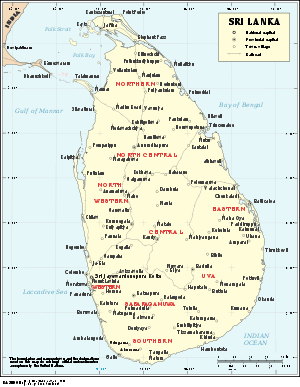Locomotives of Sri Lanka Railways

Locomotives and trainsets of Sri Lanka Railways consist mostly of diesel locomotives and multiple units. Steam locomotives are no longer used, except on heritage trains, such as the Viceroy Special.
The first locomotives pulled trains on the original segment of the Main Line, on 54 kilometres (34 miles) connecting Colombo and Ambepussa.[1] In 1953, Sri Lanka Railways enhanced its service to more power with diesel locomotives.[2] Since then, various types of diesel locomotives were added to the service.
History
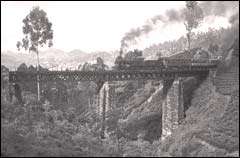
Sri Lanka's first railway locomotive was Leopold, in 1864. It was one of seven 4-4-0 locomotives built that year for the Ceylon Government Railway by Robert Stephenson and Company (nos. 1–5) and Beyer, Peacock and Company (nos. 6 and 7).[3] Many more steam locomotives were added to the system, through to the 1950s. All the steam locomotives bar three were manufactured in the United Kingdom; the exceptions were three 4-4-0s built at the railway's Maradana Works near Colombo in 1900 and 1905. In 1938, locomotives were reclassified, based on wheel arrangement and gauge. Sub-classification was based on weight, modifications, heating type, boiler capacity, or other features.[4]
Throughout its history, Ceylon Government Railway had 410 steam locomotives.[5]
The Railways upgraded its service to diesel locomotives, under the leadership of B. D. Rampala in the mid 1950s.[2] In 1953, the first locomotives from British builder Brush Bagnall were imported. Since then, the Railways have imported locomotives from Canada, Japan, West Germany, India, France, and China[6][7][8]
In the 1990s, Sri Lanka Railways converted the narrow gauge (2 ft 6 in (762 mm)) Kelani Valley line into broad gauge (5 ft 6 in (1,676 mm)). This was the last narrow gauge line left in Sri Lanka, and its conversion to broad gauge put the fleet of narrow gauge locomotives out of use. All operational locomotives in the country today are broad gauge.
As of August 2011, Sri Lanka does not have commercially operational electric locomotives or train sets. Electrification has been proposed, to improve energy efficiency and sustainability.[9]
Liveries
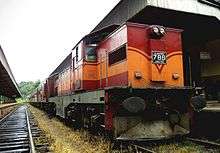
Sri Lanka's locomotives have appeared in several different liveries over the years.
The steam locomotives were mainly black.
With the introduction of diesel locomotives, coloured liveries appeared. Typical for many locomotives is a livery that has thick horizontal bands of dark blue, light blue, silver and a yellow stripe. Also common for many locomotives is a livery of horizontal bands of green, brown, and a yellow stripe. Various other liveries also exist. M6 ICE locomotives have a unique ICE livery of brown and orange.
The DMUs are painted in various liveries, unique to their classes. Typically they feature horizontal bands of colour running their entire length and a solid colour on the front and back ends.
Numbering
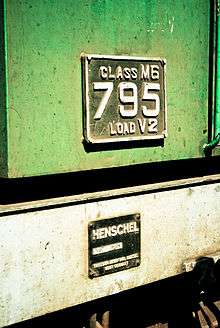
Steam locomotives were numbered from 1 upwards, reaching 161 in 1911. Whereafter replacement locomotives were given the same number as the locomotive that they replaced with an "R" prefix; until such time as the old locomotive, now running with an "O" prefix, was finally withdrawn.[10] This system was abandoned in 1928,[10] with new locomotives being numbered from 249 upwards,[11] and reaching 336 by 1940, and 362 in 1951 when the last steam locomotive — a 4-8-0 from W. G. Bagnall — was delivered.[12]
Narrow gauge locomotives were numbered in the same list as broad gauge locomotives. Diesel locomotives and multiple unit numbering started from 500 – an Armstrong Whitworth 122 hp 0-4-0 diesel-electric shunter delivered in 1934[12] – and reached 840 in 1991.[13] and included one locomotive experimentally converted to electric traction.[4][14]
Steam locomotives
Steam locomotives were used on regular services until the 1970s.[2][4]
| Photo | Class | Numbers | Type | Quantity | Manufacturer | Year | Notes |
|---|---|---|---|---|---|---|---|
| — | 1–15, 24–25, 28–29, 39–40, 43–47 | 4-4-0 | 26 | R. Stephenson & Co. (5) Beyer, Peacock & Co. (7) Kitson & Co. (14) | 1864–1880 | 5-foot driving wheels | |
| — | 20–23, 26–27 | 4-4-0 | 6 | Beyer, Peacock & Co. (4) Kitson & Co. (2) | 1868–1872 | 6-foot driving wheels; 16″×22″ cylinders | |
| — | 63–71, 89–92 | 4-4-0 | 13 | Dübs & Co. | 1892–1895 | 6-foot driving wheels; 17″×24″ cylinders | |
| — | 16–19, 41–42 | 0-6-0 | 6 | John Fowler & Co. | 1868–1878 | ||
| — | 30–31 | 0-4-0ST | 2 | R. Stephenson & Co. | 1868 | Ex Breakwater branch; absorbed in 1874; a third loco was not taken into stock | |
| — | 32–38, 48 | 4-4-0T | 8 | R. Stephenson & Co. (3) Kitson & Co. (5) | 1876–1880 | ||
| — | 30–31, 1 (second) | 4-4-0 | 3 | CGR Maradana Works | 1900–1905 | 5-foot driving wheels; 16″×24″ cylinders | |
| — | 163 | 0-6-0CT | 1 | Hawthorn, Leslie & Co. | 1913 | Crane tank | |
| A1 | 18–19, 41–42 | 4-8-0 | 4 | Kitson & Co. | 1913–1921 | ||
| A2 | 155–156 | 4-8-0 | 2 | Kitson & Co. | 1911 | renumbered 16–17 | |
| A3 | 275–278, 296–297, 334–336, 357–362 | 4-8-0 | 15 | Hunslet Engine Co. (6) W. G. Bagnall (9) | 1928–1951 | ||
| B1 | 4, 30, 242–262, 279–290 294–295 347–342 351–356 | 4-6-0 | 49 | Beyer, Peacock & Co. (25) Armstrong Whitworth (12) R. Stephenson & Co. (12) | 1927–47 | “Governor” class – many named; no. 30 Sir Thomas Maitland, runs the Viceroy Special service.[4][15] | |
| B2 | 1, 3, 25–29, 39–40, 43–47 193–196, 204–213, 222–228 | 4-6-0 | 35 | Kitson & Co. (3) R. Stephenson & Co. (11) Vulcan Foundry (21) | 1925–1925 | No. 213 preserved and operational | |
| B3 | 8–11, 22, 169–171, 185–192 | 4-6-0 | 16 | Kitson & Co. | 1913–1914 | ||
| B4 | 72–75, 147–147, 158–159 | 4-6-0 | 9 | Neilson & Co. (4) Kitson & Co. (5) | 1893–1912 | ||
| B5 | 76–80 | 4-6-0 | 5 | Neilson & Co. (3) Vulcan Foundry (2) | 1894 | ||
| B6 | 49–62 | 4-6-0 | 14 | Kitson & Co. (10) Vulcan Foundry (4) | 1882–1890 | ||
| B7 | 81–88 | 4-6-0 | 8 | Hawthorn Leslie & Co. | 1894 | ||
| B8 | 214–219, 239–240 | 4-6-0 | 18 | Hunslet Engine Co. (13) Hawthorn Leslie & Co. (2) Nasmyth, Wilson & Co. (3) | 1922–27 | ||
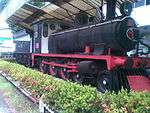 | B9 | 140–141 | 4-6-0 | 2 | Hunslet Engine Co. | 1908 | renumbered 134–135 |
| B10 | 109–119 | 4-6-0 | 11 | Dübs & Co. | 1901 | ||
| C1 | 241, 343–350 | 2-6-2+2-6-2 | 9 | Beyer, Peacock & Co. | 1927, 1945 | 1945 locos later converted to oil firing | |
| D1 | 270–274 | 2-6-4T | 5 | R. Stephenson & Co. | 1928 | “College” class, most named; | |
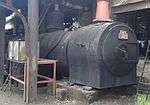 | D2 | ||||||
| D3 | 12–15, 20–21, 131–139, 150–151, 164–168 | 2-6-4T | 22 | R. Stephenson & Co. (20) Hawthorn, Leslie & Co. (2) | 1907–1914 | 131–139 renumbered 32–37, 131–133; 150–151 renumbered 38, 40; 12 rebuilt as class D1 and numbered 298 in 1930; D3 class saturated, reclassified D2 when superheated | |
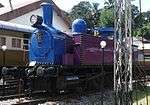 | E1 | 23–24, 93–94, 101 162, 179–183, 197–200 | 0-6-0T | 15 | Dübs & Co. (3) North British Loco. Co. (5) Hunslet Engine Co. (7) | 1898–1915 | Most rebuilt as 0-6-2T; No. 93 built in 1898 is the oldest surviving steam locomotive in the country - now at National railway museum, Kadugannawa |
| E1 | 265–269 | 0-6-2T | 5 | R. Stephenson & Co. | 1928 | ||
| F2 | 2, 5–7, 144–157, 172–173 | 4-4-0 | 20 | Vulcan Foundry (5) North British Loco. Co. (15) | 1911–1913 | 144–151 delivered as 152–154, 157–161; F2 saturated, reclassified F2 when superheated. All scrapped | |
| F3 | 95–100, 124–129 | 4-4-0 | 12 | Dübs & Co. (6) Kitson & Co. (2) North British Loco. Co. (4) | 1900–1903 | ||
| H1 | 293 | 2-4-0+0-4-2 | 1 | Beyer, Peacock & Co. | 1930 | Narrow gauge Garratt | |
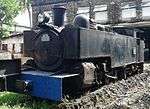 | J1 | 220–221, 263–264, 291–292 | 4-6-4T | 6 | Hunslet Engine Co. | 1924–1929 | Narrow gauge |
| J2 | 142–146, 160–161, 174–178, 184, 201–202 | 4-6-4T | 15 | Hunslet Engine Co. (11) North British Loco. Co. (4) | 1908–1919 | Narrow gauge; 142–146 renumbered 136–140 | |
| K1 | 102–108 | 4-4-0T | 7 | Hunslet Engine Co. | 1900–1901 | Narrow gauge | |
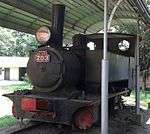 | L1 | 120–123, 130, 203 | 0-4-2T | 6 | Sharp, Stewart & Co. (4) Hunslet Engine Co. (2) | 1902–1904, 1920 | Narrow gauge |
| R1 | 301–313 | Steam railcar | 13 | Sentinel | 1925–1927 | Some were later fitted with small under-floor diesel units and were reclassified T2 | |
| R2 | 317–320 | Steam railcar | 4 | Sentinel | 1928 | Some were later fitted with small under-floor diesel units and were reclassified T2 | |
| R3 | 321–327 | Steam railcar | 7 | Sentinel | 1928 | Some were later fitted with small under-floor diesel units and were reclassified T2 | |
| R4 | 314–316 | Steam railcar | 3 | Clayton | 1928 | Some were later fitted with small under-floor diesel units and were reclassified T2 | |
| V1 | 328–330 | Steam railcar | 3 | Sentinel | 1927 | Narrow gauge | |
| V2 | 331–333 | Steam railcar | 3 | Sentinel | 1928 | Narrow gauge | |
Diesel locomotives
| Class | Type |
|---|---|
| M | Diesel Electric Locomotives |
| W | Diesel Hydraulic Locomotives |
| G & Y | Shunters |
| N & P | Narrow Gauge Locomotives |
| S | Diesel Multiple Units |
| T | Diesel Rail Cars |
Class M — Diesel Electric Locomotives[16]
Diesel locomotives of Sri Lanka Railway are categorized into several classes and their sub classes.
| Photo | Class | Numbers | Type | Quantity | Manufacturer | Year | Model | Power | Notes |
|---|---|---|---|---|---|---|---|---|---|
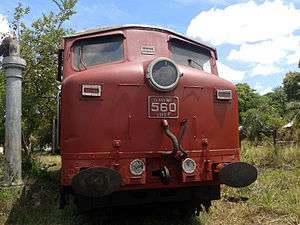 | M1 | 539–563 | A1A-A1A de | 25 | Brush Bagnall Traction | 1952 | — | 1000 hp | Currently not in service |
 | M2 | 569–573 591–595 626–629 | A1A-A1A de (12) Bo-Bo (2) | 14 | General Motors Diesel (12) Electro-Motive Division (2) | 1954–1966 | G12 | 1400 hp | All but one (571 Saskatchewan) still in active service |
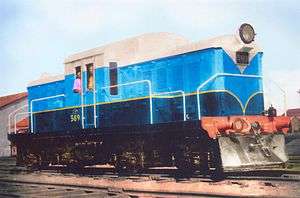 | M3 | 589–590 | Bo-Bo de | 2 | CGR | 1956–1958 | 360 hp | Engines (180 hp × 2) taken from S1 class | |
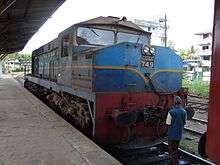 | M4 | 743–756 | Co-Co de | 14 | Montreal Locomotive Works | 1975 | MX-620 | 1750 hp | |
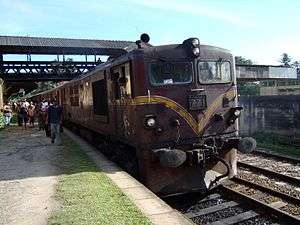 | M5 | 767–782 | Bo-Bo de | 16 | Hitachi | 1979 | 1150 hp | M5A: Re-engined locally using MTU V12 in 1991; M5B: Re-engined locally using Paxman V12 in 1997; M5C: Re-engined locally using Caterpillar 3516 DITA. | |
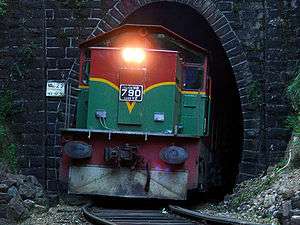 | M6 | 783–798 | A1A-A1A de | 16 | Thyssen-Henschel | 1979–1980 | G22 | 1650 hp | |
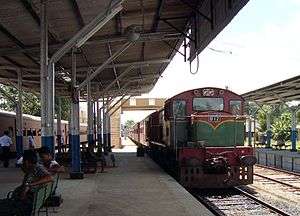 | M7 | 799–814 | Bo-Bo de | 16 | Brush Traction | 1981 | 1000 hp | ||
 | M8 | M8 (841-848), M8A (877,878) | Co-Co de | M8 (8), M8A (2) | Diesel Locomotive Works | M8 (1995), M8A (2001) | WDM-2 | M8 (2600 hp), M8A (1950 hp) | Sub Class M8A: Only 2 locomotives were introduced |
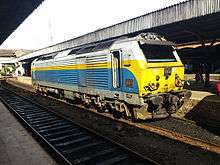 | M9 | 864–873 | Co-Co de | 10 | Alstom | 2000 | AD32C | 1800 hp | Several units out of service shortly after introduction due to cost of spares and repair. |
 | M10 | M10 (914-916), M10A (940-945) | Co-Co de | M10 (3), M10A (6) | Diesel Locomotive Works | 2012 | WDM3D | 3300 hp | Sub class M10A was introduced in 2013 which is a technical variant.[17] |
Class W — Diesel Hydraulic Locomotives[14]
| Photo | Class | Numbers | Type | Quantity | Manufacturer | Year | Model | Power | Notes |
|---|---|---|---|---|---|---|---|---|---|
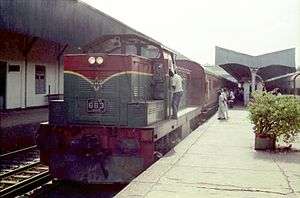 | W1 | 630–674 | B-B dh | 45 | Rheinstahl Henschel | 1968–69 | 1150 hp | 10 rebuilt with Caterpillar engines and reclassified W3. Only 2 locomotives are in operation. | |
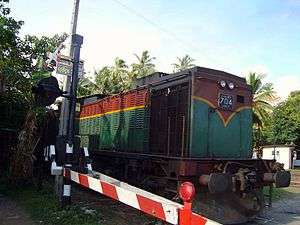 | W2 | 703–716, 729 | B-B dh | 15 | LEW | 1968 | 1500 hp | 729 ex demonstrator, ran as DR V150.001; imported 1970. Several re-furbished and in operation. | |
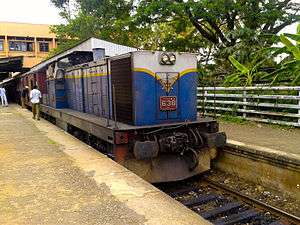 | W3 | 631…674 | B-B dh | 10 | (1997) | 1150 hp | 10 rebuilt from class W1 with Caterpillar engines. Mainly used in up country line. | ||
Classes G and Y — Shunters [18]
| Photo | Class | Numbers | Type | Quantity | Manufacturer | Year | Model | Power | Notes |
|---|---|---|---|---|---|---|---|---|---|
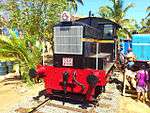 | G1 | 500 | 0–4–0 de | 1 | Armstrong Whitworth | 1934 | 122 hp | Sulzer engine. Not in use. | |
 | G2 | 531–538 | Bo-Bo de | 8 | North British Loco. Co. | 1950 | 625 hp | Paxman V8 engine. Not in use. | |
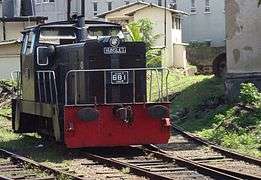 | Y | 675–702 | 0-6-0 dh | 28 | Hunslet Engine Co. | 1968 | 530 hp | Still in operation. | |
| Y1 | 721–728 | D dh | 8 | Sri Lanka Railways | 1972–73 | Paxman V12 engine. Not in operation. | |||
Classes N and P — Narrow Gauge Locomotives [14]
| Photo | Class | Numbers | Type | Quantity | Manufacturer | Year | Model | Power | Notes |
|---|---|---|---|---|---|---|---|---|---|
| N1 | 564–568 | 1C1 dh | 5 | Krupp | 1952–53 | 500 hp | Not in use. | ||
 | N2 | 730–732 | B-B dh | 3 | Kawasaki | 1973 | 600 hp | GM Detroit Diesel V16 engine. Ordered by Sri Lanka Veneers & Plywood. Not in use. | |
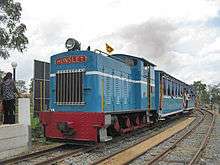 | P1 | 527–530 | 0-6-0 dm | 4 | Hunslet Engine Co. | 1950 | 120 hp | Not in use. | |
Note: One class N2 locomotive was re-classified as Class E1 after fitting with Alstom pantographs, to be run under electric power. Not to be confused with the steam locomotive E1, this electric locomotive is not in commercial use. One class P1 locomotive was at Viharamahadevi (Victoria) Amusement Park[14]
Class S - Diesel Push Pull Trains [8]
S1–S8 Diesel Hydraulic Multiple Units, S9–S12 Diesel Electric & Electro-Diesel Multiple Units
| Photo | Class | Numbers | Type | Quantity | Manufacturer | Year | Model | Power | Notes |
|---|---|---|---|---|---|---|---|---|---|
| S1 | 501–503 | 4-car | 3 | English Electric | 1938 | 400 hp | Named Silver Foam, Silver Spray, and Silver Mist. Not in operation, and power cars scrapped. | ||
| S2 | 574–588 | 15 | Schindler Carriage and Wagon | 1958 | 500 hp | Not in operation and the power cars were scrapped. | |||
 | S3 | 596–620 | 25 | Maschinenfabrik Augsburg-Nürnberg, (MAN) | 1959 | 880 hp | Not in operation. | ||
| S4 | 621–624 | 5 | Maschinenfabrik Augsburg-Nürnberg, (MAN) | 1961 | 1000 hp | Out of service. | |||
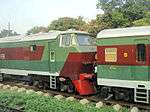 | S5 | 717–720 | 5-car | 2 sets | Hitachi | 1970 | 880 hp | Hitachi Tourist excursion train. Now one is in Airport Express service, operated by Airport & Aviation Services (Sri Lanka) Limited. | |
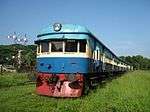 | S6 | 733–742 | 10 | Hitachi | 1974 | 1150 hp | Very similar in appearance to S7. Operated mainly on the broad gauged Kelani Valley line. Currently used as presidential train. | ||
 | S7 | 757–766 | 10 | Hitachi | 1977 | 1000 hp | Very similar in appearance to S6. Operated mainly on the broad gauged Kelani Valley line. Not in regular operations. | ||
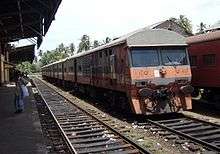 | S8 | 821–840 | 20 | Hyundai | 1991 | 1150 hp | Currently in operation. | ||
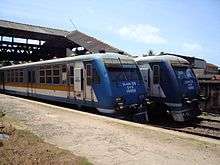 | S9 | 849–863 | 20 | CSR | 2000 | 1150 hp | Currently in operation. | ||
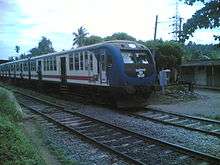 | S10 | 879-893 | 15 | CSR | 2008 | Currently in operation. | |||
 | S11 | 894–913 | 20 | RITES Ltd | 2011–2012 | 1360 hp | [19] Designed with multi class accommodation. | ||
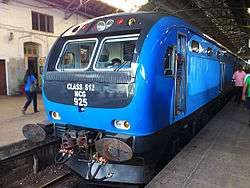 | S12 | 917–939 | 9 | CSR | 2012 | Imported in three variants, to run on the Kelani Valley line and Main line. | |||
Class T - Diesel Rail Cars [14]
The various Railbus units that are currently operated are not listed below.
| Photo | Class | Numbers | Type | Quantity | Manufacturer | Year | Model | Power | Notes |
|---|---|---|---|---|---|---|---|---|---|
| T1 | 504–526 | 23 | English Electric | 1947 | 200 hp | Coupled in Twin Units. Not in use. | |||
| T2 | (1950) | Converted steam rail car in 1950. Not in use | |||||||
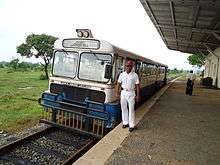 | Locally built rail buses | RB1 to .. | Rail Bus | SLR Rathmalana Works | (1995) | Based on Tata & Ashok Leyland Buses | A total of 14 Rail Buses were built
between 1995 and 2002 with numbers RB1 to RB14. |
Other Locomotives
Some other diesel locomotives (typically shunters) are available and operated in Sri Lanka other than the locomotives and shunters owned by Sri Lanka Railways. Some are the locomotives owned by Sri Lanka Ports Authority and Holcim Sri Lanka limited.
| Photo | Owner | Locomotives | Quantity | Type | Manufacturer | Year | Model | Power | Notes |
|---|---|---|---|---|---|---|---|---|---|
| Sri Lanka Ports Authority | 19 (3 in operation) | Andrew Barclay | |||||||
| Holcim Sri Lanka Limited | Deutz shunters (03), Hunslet shunter (01), Diesel Locomotive Works locomotives (02), Refurbished Beaver shunters (04), SAN locomotive (01) | All are diesel hydraulic type except DLW locomotive which is diesel electric. | Some are not in use. However this limited cater locomotives from SLR for some services. |
Locomotives and trainsets on order
In 2013, the railways ordered new trainsets from CSR to replace locomotive-hauled trains.[20] They would replace an aging fleet of locomotives.
- Long-haul S13 DMUs from China's CSR Corporation Limited[21]
See also
References
- ↑ "Ceylon Railway Enthusiasts Circle (CREC)/SLRF". Sri Lanka Railway 145th Anniversary Trip. 2010-01-02.
- 1 2 3 "The Island". Rampala regime in the local Railway History. 2010-07-19.
- ↑ Hughes 1990, p. 93.
- 1 2 3 4 http://www.infolanka.com/org/mrail/locos1.html Steam Locomotives
- ↑ "Sri Lanka (Ceylon) Railways Steam Locomotive and Steam Railcar Fleet". National Railway Museum - Sri Lanka. Archived from the original on 13 September 2012. Retrieved 7 January 2013.
- ↑ "Diesel Locomotives of Sri Lanka : Locomotive classification". www.srilankanlocos.com. M9. Archived from the original on 28 December 2012. Retrieved 9 July 2011.
- ↑ http://www.infolanka.com/org/mrail/locos2.html
- 1 2 http://www.infolanka.com/org/mrail/locos3.html Suburban Diesel Push-Pull types
- ↑ "Daily News". IESL proposes railway electrification project. 2010-12-25. Archived from the original on 2012-03-08.
- 1 2 Hughes 1990, p. 97.
- ↑ Hughes 1990, p. 94.
- 1 2 Hughes 1996, p. 92.
- ↑ Hughes 1996, p. 95.
- 1 2 3 4 5 http://www.infolanka.com/org/mrail/locos4.html Mainline Diesel Hydraulic & Narrow Gauge
- ↑ Viceroy Vintage Train Tours Archived 2011-08-28 at the Wayback Machine.
- ↑ http://www.infolanka.com/org/mrail/locos2.html Mainline Diesel-Electrics
- ↑ http://slrailwiki.wikinet.org/wiki/Class_M10 Class M10
- ↑ http://www.infolanka.com/org/mrail/locos5.html Diesel Railcars & Shunters
- ↑ "ColomboPage". India hands over new power sets for Sri Lanka's Southern Railway Line. 2011-03-11.
- ↑ "Dailynews". Power sets to steam long distance travel. 2010-09-03.
- ↑ "Dailynews". Railway gets new power sets from China. 2010-04-23. Archived from the original on 2012-03-08.
- Hughes, Hugh (1990). Indian Locomotives: Part 1 – broad Gauge 1851–1940. Harrow, Middlesex: The Continental Railway Circle. pp. 93–99. ISBN 0-9503469-8-5.
- Hughes, Hugh (1994). Indian Locomotives: Part 3 – Narrow Gauge 1863–1940. Harrow, Middlesex: The Continental Railway Circle. p. 31. ISBN 0-9521655-0-3.
- Hughes, Hugh (1996). Indian Locomotives: Part 4 – 1941–1990. Harrow, Middlesex: The Continental Railway Circle. pp. 92–95. ISBN 0-9521655-1-1.
